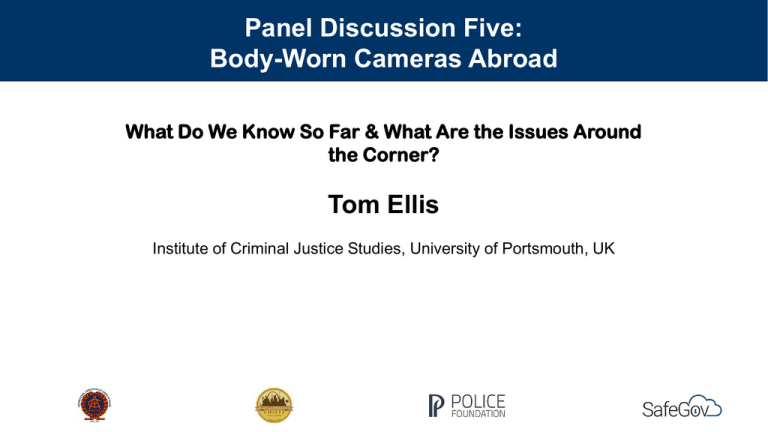View The Presentation
advertisement

Panel Discussion Five: Body-Worn Cameras Abroad What Do We Know So Far & What Are the Issues Around the Corner? Tom Ellis Institute of Criminal Justice Studies, University of Portsmouth, UK http://eprints.port.ac.uk/16979/ http://tinyurl.com/h4r6ntr Follow up study Larger study on mainland city, approx. 250,000 pop. Personal issue to all PATROL officers (effectively mandatory use) • AIM: o identify enabling and hindering features of BWVC use affecting efficiency and effectiveness o report to operational managers o recommend changes o evaluate impact of changes Technology Acceptance Model (TAM) • DESIGN: Utilization focused action research • METHODS: Human factors/contextual design – secondary data analysis – Focus groups and semi-structured interviews THIRD STUDY: Promoting justice: Professionalizing frontline policing with an evidencebased Structured Interview Protocol AIM: Enable front line/patrol officers to elicit high quality information from witnesses, victims, and persons of interest, in order to improve quality of evidence, resolution, prosecution, conviction etc. DESIGN & METHODS: Based on psychological theory of strategic control of memory reporting, and psychological developments in investigative interviewing, esp SelfAdministered Interview‘ (SAI - Gabbert, Hope et al) . • Develop, test and train for on street 'Structured Interview Protocol' to strengthen FIRST ACCOUNT • Randomised controlled trials (RCT) of the interview protocol in the field, with the College of Policing providing expert oversight and a quality assurance role. • Double blind review of video camera footage to rate quality • Correlate quality with CJ outcomes WHAT WE KNOW SO FAR IF YOU ARE SETTING UP/ROLLING OUT: Your operational roll out determines your research design • If you want to give all patrol officers BWCs, you cannot use RCT evaluation to determine whether cameras ‘work’ • But you can use BWCs do carry out RCTs on all other patrol and CJ developments (eg First account protocols) • If you roll out on voluntary, pooled, staggered etc, basis, it limits the quality of any evaluation YOU NEED TO THINK ABOUT THESE TOGETHER AT THE BEGINNING WHAT WE KNOW SO FAR Exploiting differences in emphasis in different countries USA • BWV affect on police behaviour and professionalism • Rialto: complaints and use of force • Mesa: reducing civil liability, complaints & operational transparency • Both - enhancing criminal prosecution CANADA • Bureaucratic burden/FIDO • Public perceptions of professionalism UK/E&W • Impact on crime and incivilities • Procedural justice, public confidence/opinion • Criminal justice process outcomes o o o o early guilty pleas more successful prosecutions better evidence reducing paper work WHAT WE KNOW SO FAR: CAMERAS IN CONTEXT The cameras require study per se (ease of use, capability, battery life, durability, attitudes of officers, quality of use) BUT they are relatively small part of implementing and managing BWV use. • Popular with patrol officers who use them (and with public) • BUT Unpopular (esp. initially) with investigation teams • Joint link of with prosecutions and court systems • STORAGE & RETRIEVAL (exponential growth of data vs investment in exponential developments in storage and data mining, bookmarking etc.) CAN YOUR CJ IT SYSTEMS ROUTINELY PRODUCE THESE DATA FOR ALL CALLS AND CRIME? WHAT WE KNOW SO FAR COSTS • Short terms reductions in patrol officers’ paperwork, and therefore more time on patrol • IF your CJ process accepts video evidence to some extent INSTEAD of paper/written electronic files • AND CJ IT system linked to camera metrics/data • Short term increases in investigation and processing of BWVC evidence UNTIL training and protocols take effect • Short term increases in IT and associated costs • Long term savings in terms of unit cost of cases, but no. of cases likely to increase CONSIDERATIONS FOR THE FUTURE Factors we can & cannot (yet) include in RCTs • • • • Gender Length of service Age Type of incident • Camera yes/no? • (Camera switched on?) • (Disciplinary record) • %Camera switched on in all appropriate encounters? • Leadership role & implementation factors • Amount/quality of BWV training • Technology acceptance measures (& change in it) • Quality of use of camera narrative • Quality of evidence to prosecutors • Use of structured approach SAI • Avoiding ‘investigation’ questions on the front line Standardised Technology Acceptance Model (TAM) Validated method of assessing ‘culturally’ relevant information that identifies the gap between behavioural intentions in relation to BWV cameras (in this case) and the actual use of them • Control groups need to match on TA - & changes in it over time • Relationship to training impact is variable Whether BWVCs ‘work’ now overtaken by events • Meanwhile: • • • • • • Traffic wardens Prison Officers Youth justice supervisors Special forces Private Security Guards Doormen/bouncers/ wellbeing wardens Film or be filmed! http://www.citylab.com/crime/2014/10/in-brazil-where-police-killings-are-commonplace-cellphone-cameras-play-a-powerful-role/381212/ • Do you want to rely on everyone else’s (potentially partial/edited) footage? • Or ensure you have your own, which is high quality through training on evidential value? • Ambulance crews • A&E crews • Carers in homes for elderly/others • Fire service • ASDA (Walmart) Home Delivery • AND CRUCIALLY? 3 options • RCT – policing as quasi experiment to prove cameras ‘work’ (if you have no BWV cameras already and have large numbers) • Use of cameras alongside evaluation to develop Management Information Systems and dashboards, upgrade IT to incorporate other developments, digital files, smartphones, etc. (if you can give every patrol officer a BWV camera) • Just do what you have to, to comply! Just around the corner • Streaming to preserve evidence http://www.bbc.com/news/uk-31558269 • Standalone cameras = poor quality, only docking into a back officer system puts them above smart phones • Cloud storage with smart data mining • Combined with overhead drones for public order, chases,etc. • Investigation issues: – Officer view vs investigator follow up – 360O cameras/infra red for investigations 360 camera – http://www.theverge.com/2015/7/29/9066323/foals-mountain-gates-video-virtual-reality – Officers viewing/cognitive interview contamination

